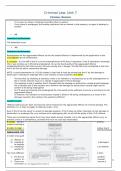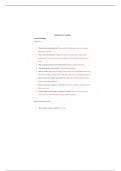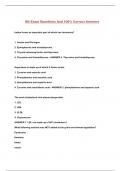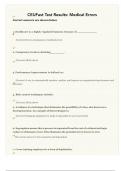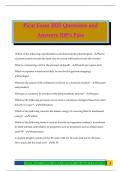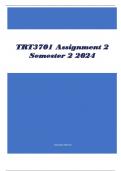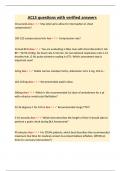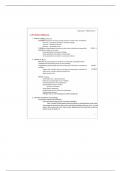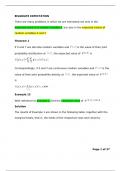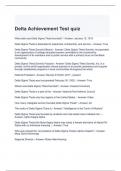Criminal Law: Unit 7
CRIMINAL DAMAGE
Outcomes
- If I co-own my house, it belongs to another (the co-owner);
- If my house is mortgaged, the lending institution has an interest in the property, so again it belongs to
1. Demonstrate a comprehensive knowledge and understanding of the offences of simple and aggravated criminal
another
damage and the statutory defence of lawful excuse
2.Tackle complex problem questions systematically by analysing the facts and applying legal knowledge accurately
and comprehensively
MR
3. Demonstrate originality in making legal submissions on behalf of 2 defendants and represent them in the context of
a trial in a logical and persuasive way
Intention/recklessness
The defendant must:
The majority of criminal damage offences will result in damage valued at less than £5,000, and these can only
be dealt with intothe magistrates’ court.
a)
intend
MR damage/destroy property or be reckless as to such damage/ destruction; and
b) know that the property
Criminal damage by fire is known as ‘arson’ belongs to another or be reckless
and is triable as to
either way. whether
The the property
aggravated criminalbelongs
damage to another
Intention/recklessness
offences, where the defendant intended or was reckless as to endangering the life of another, are more serious
The
and test for recklessness
are thus indictable only is subjective
offences (i.e. where the D has recognised the risk and gone on to take the risk)(R
Recklessness
v G). for the aggravated offence (as for the simple offence) is determined by the application of the
Cunningham
The offences test of recklessness.
of criminal damage to be found in the Criminal Damage Act 1971, comprise:
If a person honestly believed property was his own, he lacks the MR of criminal damage. It did not matter
R v Dudley
whether the- belief
a. S1(1) It–issimple
thewasMR of the D
reasonably
criminal asheld
to the
damage; as endangerment
long as it was an of honest
life thatbelief
is important: if the D intended to endanger
(R v Smith).
life or was reckless as to life being endangered, he can be found guilty of the aggravated offence
Lawfulb. S1(2)
excuse
notwithstanding – aggravated
the fact that criminal
no-one’s damage;
life was actually put in danger. The MR had to be considered at the time
c. S1(3) and s1(1) – simple
the D did the act which caused the damage. arson;
An offence is committed if property is intentionally or recklessly damaged or destroyed without lawful excuse.
d. S1(3) and s1(2)- aggravated arson;
NOTE: A close examination of s 1(2)(b) makes it clear that it must be proved that the D ‘by the damage or
Under section 5(2)(a) of to –the Criminal Damage Act 1971, to athat
D will have lawful
destruction’
When analysing intended
liability endanger
start withlifetheorlowest,
was reckless
and work yourpossibility
way up the v excuse
Steer). (and therefore a defence to
(Roffences…
a charge of criminal damage under s 1(1) of the Act) if he argues either:
Simple
- criminal
The fact that,damage (section
by shooting 1(1) of the
at someone, Criminal
there Damage
is an intention orAct 1971)
recklessness as to the endangerment of
a) life
thatishe believed he had the onconsent of the person who criminal
was entitled to give permission for the damage
not the relevant issue a charge of aggravated damage
to
ARbequestion
caused (eg he isthought hethehadDpermission from the owner of or the property); or
- The to ask whether intended that the damage destruction caused should endanger
b) life
thator hewhether
believed he had the consent of the person who he thought was entitled to give permission
There are three elements the D was reckless as to whether the damage (or destruction) caused might lead to for
the damage be making up
(egthe
he actus reus
heof thepermission
offence, namely:
lifetobeing caused thought had from someone whom he (wrongly) believed
another’s endangered
to be
if itthe owner of the property); or
-a) So were
Damage/destruction the shooting that endangered life, this would not be sufficient to secure a conviction for the
c) aggravated
that he believed he would have had the consent of the person entitled to give permission if that person
b) Of property offence
had known of the damageor and the circumstances;
-c) If, however,
Belonging tothe intention
another recklessness related toorEileen’s life being endangered as a result of the
d) damage
that he believed he would have had the consent of the person who he thought was entitled to give
caused to the window, this would be sufficient
Destroypermission
or damage if that person had known of the damage and the circumstances
Lawful excuse
Under section
There does not5(2)(b)
have to ofbetheextensive
Criminal damage.
Damage Act 1971, a D will have lawful excuse if he can argue that:
‘Without lawful excuse’ does not have the same meaning for the aggravated offence of criminal damage. The
a) heinis
If expense
definition believed
5 doesproperty
sinvolved (his
in restoring
not apply to own or another’s)
the property
offences underto sitswas in immediate
previous
1(2). condition,need
theof protection;
court is likely AND
to find that damage is
established (Hardman
b) he believed thatv Chief Constable
the means of Avon and
of protection Somerset
he adopted Constabulary).
(which led to the criminal damage) were
Even if the D has the
reasonable owner’s
having consent
regard to alltothe
damage property, if the D does so either intending, by the damage or
circumstances
This may range
destruction, from a scratch
to endanger life, orcaused by running
is reckless a key down life,
as to endangering the side of still
he will a carbetoguilty
rebuilding
of theashouse destroyed
1(2) offence.
by fire.
Section 5(3) makes it clear that in both s 5(2)(a) and (b), the D’s belief does not have to be reasonable so long
There
as it isare
an circumstances
honestly held belief. when the D may have lawful excuse (outside s 5) to the aggravated offence (e.g. to
Hardmancrime
prevent - Drawings on a pavement
or in self-defence, madethe
provided by using
force hesoluble
usedchalks amounted to criminal damage as the local
was reasonable).
authority
R v Hunt -incurred
Whetherexpense or not ain cleaningact
particular it up.
of destruction or damage was done or made in order to protect
property belonging to another is an objective test.
Roe v Kingerlee - The issue of whether damage had been caused was a matter of fact and degree to be
determined in a commonsense
R v Hill; R v Hall - Whether the D way.
believed the property was in immediate need of protection and whether the D
Property
Aggravated criminal damage (s1(2) of the Criminal Damage Act 1971)
The definition
In order of property
to be guilty of an is very wide
offence under (section
s 1(2), 10(1)), and covers property of a tangible nature, whether real or
the D must:
personal, including money and the property referred to in s 10(1)(a) and (b). This includes certain animals (for
a) destroy
example, or damage
pets) and property
certain plants (actus
(for reus);those growing in the garden).
example,
b) intending to destroy or damage any property or being reckless as to whether any property is damaged
Belonging to another
or destroyed (mens rea);
c) intending by the destruction or damage to endanger the life of another or being reckless as to whether
Section 10(2) defines ‘belonging to another’ as including situations where another person has an interest in the
another’s life might be endangered (mens rea)
property
Two main differences between simple criminal damage (s 1(1)) and aggravated criminal damage (s 1(2)):
Consider situations like:
1. For the simple offence under s 1(1), the D must destroy or damage ‘property belonging to another’;
- If I rent the house, then the house will belong to another (my landlord);
under s 1(2), the property damaged or destroyed can belong to another person or to the D himself 1
2. There is an additional element of mens rea (’ulterior’ mens rea) that needs to be proved to secure a
conviction for the aggravated offence
CRIMINAL DAMAGE
Outcomes
- If I co-own my house, it belongs to another (the co-owner);
- If my house is mortgaged, the lending institution has an interest in the property, so again it belongs to
1. Demonstrate a comprehensive knowledge and understanding of the offences of simple and aggravated criminal
another
damage and the statutory defence of lawful excuse
2.Tackle complex problem questions systematically by analysing the facts and applying legal knowledge accurately
and comprehensively
MR
3. Demonstrate originality in making legal submissions on behalf of 2 defendants and represent them in the context of
a trial in a logical and persuasive way
Intention/recklessness
The defendant must:
The majority of criminal damage offences will result in damage valued at less than £5,000, and these can only
be dealt with intothe magistrates’ court.
a)
intend
MR damage/destroy property or be reckless as to such damage/ destruction; and
b) know that the property
Criminal damage by fire is known as ‘arson’ belongs to another or be reckless
and is triable as to
either way. whether
The the property
aggravated criminalbelongs
damage to another
Intention/recklessness
offences, where the defendant intended or was reckless as to endangering the life of another, are more serious
The
and test for recklessness
are thus indictable only is subjective
offences (i.e. where the D has recognised the risk and gone on to take the risk)(R
Recklessness
v G). for the aggravated offence (as for the simple offence) is determined by the application of the
Cunningham
The offences test of recklessness.
of criminal damage to be found in the Criminal Damage Act 1971, comprise:
If a person honestly believed property was his own, he lacks the MR of criminal damage. It did not matter
R v Dudley
whether the- belief
a. S1(1) It–issimple
thewasMR of the D
reasonably
criminal asheld
to the
damage; as endangerment
long as it was an of honest
life thatbelief
is important: if the D intended to endanger
(R v Smith).
life or was reckless as to life being endangered, he can be found guilty of the aggravated offence
Lawfulb. S1(2)
excuse
notwithstanding – aggravated
the fact that criminal
no-one’s damage;
life was actually put in danger. The MR had to be considered at the time
c. S1(3) and s1(1) – simple
the D did the act which caused the damage. arson;
An offence is committed if property is intentionally or recklessly damaged or destroyed without lawful excuse.
d. S1(3) and s1(2)- aggravated arson;
NOTE: A close examination of s 1(2)(b) makes it clear that it must be proved that the D ‘by the damage or
Under section 5(2)(a) of to –the Criminal Damage Act 1971, to athat
D will have lawful
destruction’
When analysing intended
liability endanger
start withlifetheorlowest,
was reckless
and work yourpossibility
way up the v excuse
Steer). (and therefore a defence to
(Roffences…
a charge of criminal damage under s 1(1) of the Act) if he argues either:
Simple
- criminal
The fact that,damage (section
by shooting 1(1) of the
at someone, Criminal
there Damage
is an intention orAct 1971)
recklessness as to the endangerment of
a) life
thatishe believed he had the onconsent of the person who criminal
was entitled to give permission for the damage
not the relevant issue a charge of aggravated damage
to
ARbequestion
caused (eg he isthought hethehadDpermission from the owner of or the property); or
- The to ask whether intended that the damage destruction caused should endanger
b) life
thator hewhether
believed he had the consent of the person who he thought was entitled to give permission
There are three elements the D was reckless as to whether the damage (or destruction) caused might lead to for
the damage be making up
(egthe
he actus reus
heof thepermission
offence, namely:
lifetobeing caused thought had from someone whom he (wrongly) believed
another’s endangered
to be
if itthe owner of the property); or
-a) So were
Damage/destruction the shooting that endangered life, this would not be sufficient to secure a conviction for the
c) aggravated
that he believed he would have had the consent of the person entitled to give permission if that person
b) Of property offence
had known of the damageor and the circumstances;
-c) If, however,
Belonging tothe intention
another recklessness related toorEileen’s life being endangered as a result of the
d) damage
that he believed he would have had the consent of the person who he thought was entitled to give
caused to the window, this would be sufficient
Destroypermission
or damage if that person had known of the damage and the circumstances
Lawful excuse
Under section
There does not5(2)(b)
have to ofbetheextensive
Criminal damage.
Damage Act 1971, a D will have lawful excuse if he can argue that:
‘Without lawful excuse’ does not have the same meaning for the aggravated offence of criminal damage. The
a) heinis
If expense
definition believed
5 doesproperty
sinvolved (his
in restoring
not apply to own or another’s)
the property
offences underto sitswas in immediate
previous
1(2). condition,need
theof protection;
court is likely AND
to find that damage is
established (Hardman
b) he believed thatv Chief Constable
the means of Avon and
of protection Somerset
he adopted Constabulary).
(which led to the criminal damage) were
Even if the D has the
reasonable owner’s
having consent
regard to alltothe
damage property, if the D does so either intending, by the damage or
circumstances
This may range
destruction, from a scratch
to endanger life, orcaused by running
is reckless a key down life,
as to endangering the side of still
he will a carbetoguilty
rebuilding
of theashouse destroyed
1(2) offence.
by fire.
Section 5(3) makes it clear that in both s 5(2)(a) and (b), the D’s belief does not have to be reasonable so long
There
as it isare
an circumstances
honestly held belief. when the D may have lawful excuse (outside s 5) to the aggravated offence (e.g. to
Hardmancrime
prevent - Drawings on a pavement
or in self-defence, madethe
provided by using
force hesoluble
usedchalks amounted to criminal damage as the local
was reasonable).
authority
R v Hunt -incurred
Whetherexpense or not ain cleaningact
particular it up.
of destruction or damage was done or made in order to protect
property belonging to another is an objective test.
Roe v Kingerlee - The issue of whether damage had been caused was a matter of fact and degree to be
determined in a commonsense
R v Hill; R v Hall - Whether the D way.
believed the property was in immediate need of protection and whether the D
Property
Aggravated criminal damage (s1(2) of the Criminal Damage Act 1971)
The definition
In order of property
to be guilty of an is very wide
offence under (section
s 1(2), 10(1)), and covers property of a tangible nature, whether real or
the D must:
personal, including money and the property referred to in s 10(1)(a) and (b). This includes certain animals (for
a) destroy
example, or damage
pets) and property
certain plants (actus
(for reus);those growing in the garden).
example,
b) intending to destroy or damage any property or being reckless as to whether any property is damaged
Belonging to another
or destroyed (mens rea);
c) intending by the destruction or damage to endanger the life of another or being reckless as to whether
Section 10(2) defines ‘belonging to another’ as including situations where another person has an interest in the
another’s life might be endangered (mens rea)
property
Two main differences between simple criminal damage (s 1(1)) and aggravated criminal damage (s 1(2)):
Consider situations like:
1. For the simple offence under s 1(1), the D must destroy or damage ‘property belonging to another’;
- If I rent the house, then the house will belong to another (my landlord);
under s 1(2), the property damaged or destroyed can belong to another person or to the D himself 1
2. There is an additional element of mens rea (’ulterior’ mens rea) that needs to be proved to secure a
conviction for the aggravated offence

